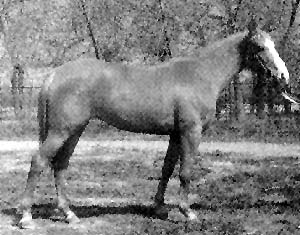
Kustanair

Introduction: If you have any comments or suggestions, please click here.
Names: Kustanai, Kustanair. I had never heard the former before I went looking for a picture; that is what I found this picture under. It seems to be the same; I will leave it as it is for now. I will call it by the name that I know better, Kustanair. Apparently named for the stud where it originated.
Origin: Most horses in southeastern Russia
are of Mongolian
origin. Many, like the Kustanair, were bred up by judicious
crossing. This breed was improved with Don
stallions. Turkmenes (or Turkomans)
were
used to produce the Adayev strain.
The Kustanai was developed in the steppes of western Kazakhstan at the
collective-farm and state-farm studs. It is found in the Kustanai region,
in the south of Chelyabinsk region, and in southern Kazakhstan. The breeding nucleus is concentrated at
Kustanai and Maikulski studs. Its development dates from 1887 to 1951. The first
date is the year of establishment of the state-owned stud, the Turgai; it was
followed by the Kustanai in 1888 and the Orenburg in 1890. The last is the date
of official recognition of the Kustanai breed.
The new breed was developed by
crossing native Kazakh
steppe horses with Don,
Stralets, Astrakhan (improved Kalmyk) and halfbred Thoroughbred
stallions. Nevertheless, at the onset the crossbreeding was unsuccessful. Only
after the nucleus of local brood mares, improved by pure breeding and regular
creep-feeding, was formed at Kustanai stud did crossbreeding with Thoroughbreds
yield a positive result. In the 1920s they began to develop a new breed at
Kustanai stud. The work was continued in the 1930's with two systems of
management. The first involved keeping in stables and on pastures, winter
grazing in good weather, abundant hay and concentrate feeding, hand mating, and
weaning of the foals at 6-8 months. The other involved improved taboon keeping,
year-round grazing and keeping in sheds in bad weather, hay and
concentrate creep-feeding, and free mating. The first method was employed at Kustanai and
Troitske studs and the second at the Maikulski and other studs.
Breeding: The
breeding work was directed at developing simultaneously two types--saddle and
steppe. The saddle type included horses with a high proportion of
Thoroughbred
blood, while the steppe type consisted of
Thoroughbred-Don-Kazakh
and other
crossbreds bred inter se. All saddlers were put to speed tests at the
hippodrome. The breeding nucleus varied
little. In 1930 the breeding herd at the Kustanai stud numbered 1,000 mares. In
1981 the Kustanai and Krasnodon studs had 726 purebred mares, and 746 Kustanai pedigree stallions were used in pure breeding and general
improvement. In 1980 the total Kustanai horse population numbered 40,200.
The breed consists of 3 intra-breed types, 5 sire lines and 6 mare
families.
Three volumes of the studbook have been published. The main breeding
centers are
the Kustanai regional experiment station (formerly a horse stud) and Krasnodon
and Saryturgai studs. The breed has good prospects for pure breeding with
limited corrective crossbreeding by the Thoroughbred.
Description: There
are three types of this breed: Steppe--heavy and slow; Riding--light; Basic--between the two
(the most popular). I chose this picture because it seemed to be the Basic
type.
The modern Kustanai is a massive horse combining the best characters of a
saddler and the pronounced basic steppe lineage. The Kustanai shows
remarkable fitness in a continental climate. The measurements (in cm) of
stallions at stud in 1980 were: height at withers 163, oblique body length 161,
chest girth 188, cannon bone girth 20.3; mares: 160, 159, 189 and 19.2. Colour:
bay, chestnut, reddish-grey, brown.
Back: Straight, wide, and short.
Chest: Wide and deep.
Color: Solid colors, usually bay or chestnut.
Croup: Medium long, occasionally short, and nicely rounded.
General: Strong tendons and ligaments. A clean and hardy build.
Head: Straight and medium sized with wide jaws and medium long, occasionally short poll.
Hooves: Hard.
Joints: Well developed.
Legs: Correctly set.
Loin: Flat, solid, and well muscled.
Neck: Medium long, straight, and low set.
Shoulders: Long and high set.
Size: 15-15.2 hands.
About 15 hands. The measurements below show that they can average 15 to 16
hands.
The measurements (in centimeters) of
stallions at stud in 1980 were: height at withers 163, oblique body length 161,
chest girth 188, cannon bone girth 20.3; mares: 160, 159, 189 and 19.2.
Withers: Wide, well muscled, and medium high.
Temperament:
Features: The
Kustanai shows remarkable speed. Its records are 1 min 40.7 sec for 1600 m, 2
min 34.7 sec for 2400 m. Horses of the basic type show good action in the Russian
harness. The record of maximum draught power is 456 kg; the average time
with a 22-kg load at the trot for 2000 m is 6 min. As an example, this
last record could be simplified to read: A little over a mile, pulling a
48 and a half pound load, in 6 minutes.
The Kustanai also has
admirable endurance. For instance, the stallion Storm covered 178 km in 15
hours; Chervonets covered 100 km in 4 hours 1 min 5 sec. The best results of a
24-hour ride is 286.1 km. The record of a 6-day 420-km ride is 22 hours 32 min
31 sec.
The fertility of Kustanai mares at some studs reaches 90%. Irrespective
of the management system employed, the Kustanai longevity often exceeds 20
years.
Uses: Good all rounder. Useful, hard harness and saddle horses.
Accomplishments:
Curiosities:
Profiles:
Conclusion: